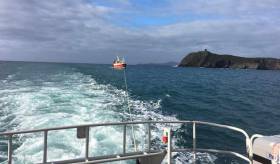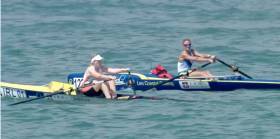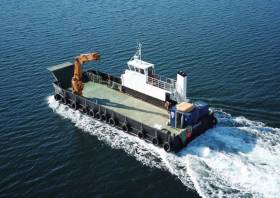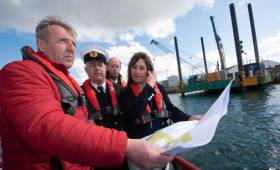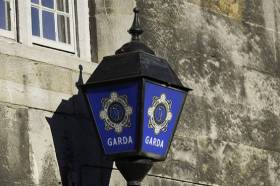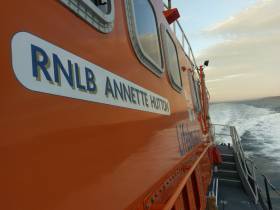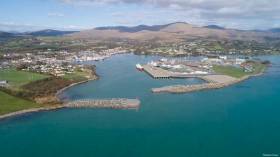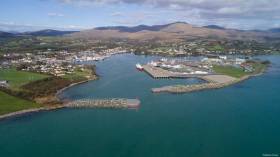Displaying items by tag: castletownbere
Castletownbere RNLI Launch to Assist Fishing Vessel off Beara Peninsula
Lifeboat crew at Castletownbere RNLI were launched early this morning just after 03.30 a.m. to assist a 19-metre fishing vessel which experienced difficulties off the Bull Rock off the Beara peninsula in West Cork.
The alarm was raised when the vessel, with four persons on board, experienced mechanical difficulties eleven miles west of the Bull Rock. The alarm was raised with Valentia Coastguard Radio requesting immediate assistance who in turn tasked Castletownbere lifeboat at 03.27 a.m.
The lifeboat was launched within minutes under the command of Coxswain Dean Hegarty and five crew and located the fishing vessel at 05.20 a.m. 28 miles west of Castletownbere Harbour. There was a 3-4 metre swell and the wind was Force 5 westerly.
The lifeboat took the fishing boat under tow shortly afterwards and brought it to safety within Castletownbere Harbour arriving at 12.00 midday.
Commenting on the callout Castletownbere RNLI Launching Authority Felix O’Donoghue said, ‘The crew are to be praised for their quick response and swift launch this morning. They spent eight and a half hours at sea and thankfully the outcome has been positive.
Healy Best of Irish at World Coastal Rowing Championships
#Rowing: Ireland’s Sionna Healy placed seventh in the women’s solo at the World Coastal Championships in Hong Kong this morning. In tough, choppy, conditions, the Arklow woman clung on to sixth for most of a race which was won by Diana Dymchenko of Ukraine. Mette Petersen of Denmark finished fastest of the entire field and took sixth, while Castletownbere’s Miriam Sheehan also finished well to take eighth.
The best-placed men’s crews for Ireland were Myross, who took tenth in the men’s coxed quadruple, and Bantry’s Andrew Hurley, who was 13th in the men’s solo.
Belfast Boat Club’s women’s coxed quad took 11th in their A Final.
World Coastal Rowing Championships, Hong Kong – Day Three (Ireland crews)
Men
Quadruple coxed – A Final: 10 Myross 24 minutes 45.44 seconds. B Final (18th to 31st): 4 Galley Flash/Kilmacsimon 17:24.36.
Double – A Final: 13 Arklow (J Whooley, A Goodison) 27:01.10.
Solo – A Final: 13 Bantry (A Hurley) 30:52.53; 16 Galley Flash (J Harrington) 32.20.18.
Women
Quadruple, coxed – A Final: 11 Belfast BC 28:06.90; 15 Castletownbere/Myross (Ireland Two) 28:45.75.
Double – B Final (17th to 29th): 1 Castletownshend 20:46.01; 4 Arklow (Kinsella, Kinsella) 22:03.93, 5 Arklow (Jordan, Reid) 22:21.76.
Solo – A Final: 7 Arklow (S Healy) 32:45.91, 8 Castletownbere (M Sheehan) 32:53.20; 12 Arklow (X Jordan) 33:25.40; 14 Galley Flash (N Hayes) 34:03.40; 16 Arkow (MA Kent) 37:22.22.
Mixed
Double – B Final (17th to 32nd): 11 Kilmacsimon 21:04.85.
Ireland Women Qualify for A Finals at World Coastal Championships
#Rowing: Five Ireland entrants in the women’s solo single made it through heats into Sunday’s A Final of the World Coastal Rowing Championships in Hong Kong. Miriam Sheehan of Castletownbere placed best, taking third in the first heat, one place ahead of Sionna Healy. The Arklow sculler was one of three from her club to make it to the A Final in this class. Both women’s coxed quadruples, from Belfast and a composite of Castletownbere and Myross, also qualified for the A Final.
The Ireland men’s crews found the going tougher. Only the top five in the heats of the men’s double were guaranteed places in the A Final. John Whooley and Alan Goodison finished sixth in their heat - making it through. The three other Ireland crews missed out.
World Coastal Rowing Championships, Hong Kong – Day One, Heats (Ireland crews)
Men
Double (Five to A Final) – Heat One: 6 Arklow 19:04.39; 10 St Michael’s, Dublin 21:28.54.
Heat Three: 8 Kilmacsimon/Ring 21:15.37; 11 Courtmacsherry 22:53.45.
Women
Quadruple, coxed (Eight to A Final) – Heat One: 7 Belfast BC 19:33.28.
Heat Two: 7 Castletownbere/Myross 20:40.31.
Solo (Eight to Final) – Heat One: 3 Castletownbere (M Sheehan) 22:07.48; 4 Arklow (S Healy) 22:16.07; 7 Galley Flash (N Hayes) 23:13.68; 8 Arklow (MA Kent) 24:41.77.
Heat Two: 6 Arklow (X Jordan) 24:02.30.
Marine Notice No 25 of 2019 from the Department of Transport, Tourism and Sport advises that there will be a deployment of ADCP current meters on the sea floor in Castletownbere, Co Cork from tomorrow, Thursday 25 July.
Current meters will be mounted in a stainless-steel frame at two locations: Lat 51°38'33.06”N, Long 009°54'42.00"W and Lat 51°38'33.00”N, Long 009°53'43.68”W.
The stainless-steel frame will be deployed from vessel An tOileanach (Callsign EI5930) for 14 days from tomorrow, subject to weather.
Surface spar-style buoys will be used to mark locations. Buoys will be a 700mm diameter yellow buoy of height approximately 1m above the water line.
The buoys will be fitted with a flashing LED light with a range of 2-3 nautical miles. The light will be set to flash 3 times every 10 seconds (duration of flash 0.3 seconds).
Castletownbere’s RNLI lifeboat sprang into action to help locate a tourist reported missing on Dursey Island in West Cork yesterday afternoon (Friday 17 May).
The lifeboat, under the command of coxswain Dean Hegarty, launched shortly after 2pm after Valentia Coast Guard radio received reports that a visitor to the island off the Beara Peninsula had gone missing.
Also tasked were the Shannon-based Irish Coast Guard helicopter Rescue 115, Derrynane Inshore Rescue Boat and the Naval Service vessel LÉ Ciara.
Once on scene, the lifeboat commenced a search of the area while Rescue 115 did a sweep of the island and spotted a person who fitted the description of the casualty.
The coastguard helicopter lowered a winchman and confirmed that the casualty was safe and well. All emergency services were then stood down.
Commenting on the callout, launching authority Paddy O’Connor said: “We are delighted at the very swift response of the crew and that the casualty was located safe and well.”
The Minister for Agriculture, Food and the Marine, Michael Creed T.D., officially opened the new Harbour Administration building in Castletownbere and took the opportunity of his visit to the town to inspect progress on the €23.5m, 216-metre long fishing quay extension project and associated works on Dinish Island as part of Project Ireland 2040.
On opening the building the Minister said; “This building provides fit for purpose offices whereby harbour users can carry out their business with the Harbour Master in a professional and modern space. The building will be shared with the Sea Fisheries Protection Authority facilitating a more efficient and effective delivery of services making it a one-stop shop for harbour users.”
"The value of landings into Castletownbere increased by 275% between 2010 and 2017"
Castletownbere is the primary urban, economic and social centre on the Beara Peninsula in South West Ireland. The harbour is one of the largest natural harbours in the world and is formed by Dinish Island to the south (hosting most of the fisheries infrastructure and processing activity) and the town of Castletownbere to the north. Castletownbere Fishery Harbour Centre is one of Ireland’s major fishing ports and is Ireland’s largest whitefish port. Proximity to rich fishing grounds makes Castletownbere an attractive fish landing location for Irish and foreign vessels.
The Minister went on to say that “The Harbour Administration Building provides a new focal point in the town and forms part of a wider and ongoing integrated Harbour Development programme. It demonstrates a commitment to rural development by this Government and spearheads further improvements in the town proposed by Cork County Council.”
In respect of the European Maritime & Fisheries Fund co-funded €23.5m, 216m quay extension on Dinish Island the Minister said; “I took this opportunity to inspect progress on this large investment in the seafood industry in Castletownbere, and I am delighted to say that it is coming in within budget and ahead of schedule.”
The quay extension project in conjunction with the new Harbour Administration building forms part of a wider Harbour Development programme. The new extended quay will almost double the landing space available to fishermen, alleviate current congestion issues and provide for the possibility of increased fish landings and opportunities for further economic diversification compatible with the fishing industry.
Between 2010 and 2017 the value of fish landings into Castletownbere increased by 275%, from €29.9m to €112.3m, with volumes increasing by 91% over the same period from 19,030 tonnes to 36,446 tonnes.
The Minister said that “when completed the new quay will future proof the seafood sector in Castletownbere, will significantly drive forward the fishing industry and local economy on the Beara Peninsula and allow for a major expansion of the seafood support sector and other marine-related industries in the South West.”
Investigation Into Human Remains Found By Fishing Vessel Off Cork Coast
Gardaí in Cork have launched an investigation after human remains were recovered by the crew of a fishing vessel 180 nautical miles off Castletownbere in Co Cork at the weekend.
TheJournal.ie reports that the vessel docked in Castletownbere on Sunday evening (20 January) and the remains were transferred to Cork University Hospital where a post-mortem was performed yesterday (Tuesday 22 January).
#Lifeboats - Castletownbere’s all-weather lifeboat launched last night (Wednesday 10 October) to a Mayday from six fisherman whose boat lost power and was drifting rapidly towards the shore.
Pagers sounded for the volunteer RNLI crew at 7.30pm following the alert to the Irish Coast Guard from the 25m fishing boat, which had fouled its propeller at the entrance to the West Cork harbour.
With time of the essence, coxswain Dean Hegarty and his four crew launched immediately and the lifeboat was on scene within five minutes, at which point the vessel was just 20 metres from the shore.
The boat had been blown into a small area by Pipers Rock at the harbour mouth in south-westerly Force 8-9 gales and amid a 4-5m swell.
The lifeboat crew worked quickly to set up a towline and rescue the boat and her crew from immediate danger before bringing them safely back to Castletownbere.
“Given the weather conditions and how close the fishing boat was drifting to the shore at this point, the lifeboat’s timely arrival managed to avert a potential tragedy,” said Paul Stevens, Castletownbere RNLI lifeboat operations manager.
“The fishermen did the right thing in raising the alarm when they did and we would like to wish them well following what must have been a challenging experience.”
#Harbours - Works on the €23.5 million quay extension at Castletownbere Fishery Harbour Centre are due to begin by September.
As previously reported on Afloat.ie, Marine Minister Michael Creed attended the signing of the contract for the 216-metre Dinish Wharf extension with L&M Keating Ltd, after the project was green-lit this past May.
The works are being advanced by civil engineering crews working both from the adjacent lands, existing harbour infrastructure, and from jack-up barges, pontoons, heavy civil engineering plant and machinery, work vessels and platforms. Divers will also be also employed on site.
For safety reasons, mariners are advised to proceed slowly and with caution in the approach channel to the inner harbour, and within the inner harbour area, and to give the
works a clear berth. Wave wash from vessels should be avoided.
According to Marine Notice No 33 of 2018, these works are expected to continue till March 2020 and include, but are not limited to:
- Construction of a new quay structure approximately 216m at Dinish Island, including all associated infilling and land reclamation.
- Dredging of a berthing pocket adjacent to the new wharf extension by dredging to a depth of -8.0m Chart Datum.
- Dredging of a navigation channel to a depth of -6.5m Chart Datum.
- Construction of two new breakwater structures.
- Construction of a reclamation area to act as a quay/storage hinterland area.
- Provision of all water, electrical and fuels services.
- Heavy-duty pavement surfacing to new wharf/quay structure area
- Ancillary marine facilities and services.
- Relocation of navigation lights.
- Revised security and access arrangements for quay facilities.
€23.5m Quay Extension for Castletownbere Harbour
The Minister for Agriculture, Food and the Marine, Michael Creed T.D., attended the signing of a contract for a €23.5 million, 216m long quay development project and associated works on Dinish Island, Castletownbere in County Cork.
Welcoming the signing of the contract with contractor L&M Keating Ltd, the Minister said “This is a very significant investment for the South West and will be a big boost to the Beara Peninsula and West Cork in general. The Project will double the workable quay space on Dinish Island in Castletownbere and will enable significant expansion in fish landings, onshore processing and general marine activity at this major port.
The Minister went on to say that “In approving this development, I have taken account of the unprecedented success of the previous development in increasing fish landings to Castletownbere. That success has resulted in the need for a further major expansion to manage current activity levels and future-proof the harbour for major expansion”
Minister Creed explained that “Government Policy is to substantially increase the landings into Ireland from all vessels that fish in the waters around Ireland. We want to see Ireland become the hub for all the marine activities that can be generated by the sustainable harvesting of these renewable resources in our marine sphere. Developing our Fishery Harbour Centres, such as Castletownbere, to facilitate our industry and be able to attract and handle these landings is a key step in achieving our ambitions in this area, in line with the Governments integrated marine development strategy “Harnessing our Ocean Wealth”
In summing up, the Minister said “I view this project as a testament not only to this Governments support for the Castletownbere fishing industry and the ongoing development of the wider seafood sector, but also to our commitment to the social and economic development of rural coastal communities. When completed, the new facilities will be on a par with the best in Europe, and will significantly drive forward the fishing industry and local economy on the Beara Peninsula and allow for a major expansion of the seafood support sector and other marine related industries in the South West. The expanded landing facilities and increased quay space will also provide opportunities for further economic diversification.”
The project has been proposed for part funding under Ireland’s European Maritime and Fisheries Fund Operational Programme, co-funded the Government of Ireland and the European Union.
The Minister concluded that “the Irish seafood industry faces on going challenges, such as the significant challenge of Brexit. By providing world class landing facilities for our industry and for the many other EU vessels that we wish to operate out of Ireland, we are protecting our coastal communities and creating the opportunity for the seafood industry to continue to grow, prosper and facilitate a simultaneous growth of other ancillary marine industries.”


























